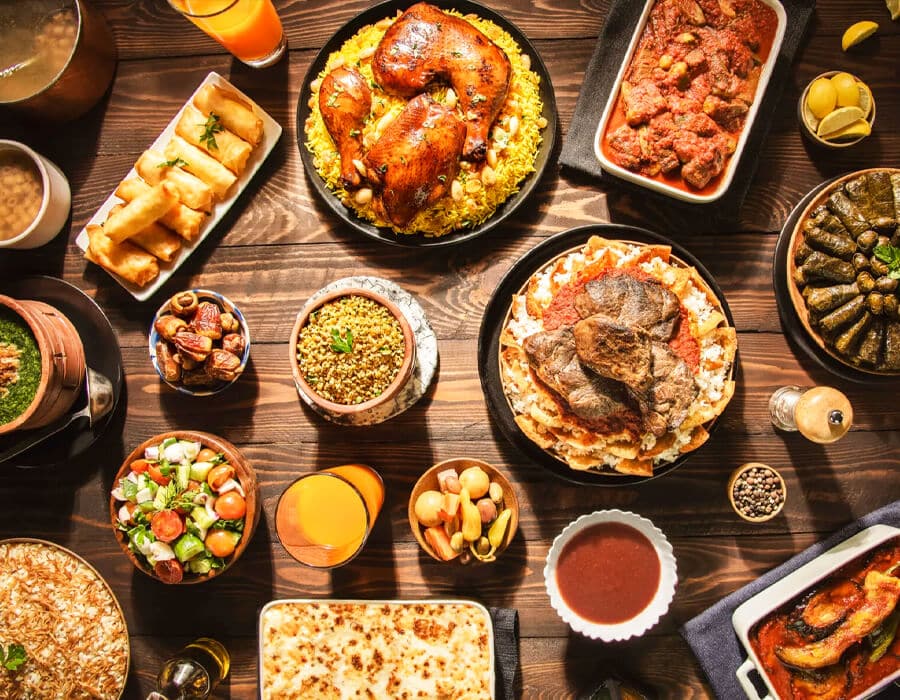Egyptian Food is far more than a collection of flavorful dishes—it reflects the nation’s ancient legacy and diverse cultural heritage. Shaped by the fertile lands of the Nile, Egypt’s food culture has evolved over thousands of years, absorbing influences from the Pharaonic era, the Ottoman Empire, Greek and Roman traders, and its African and Middle Eastern neighbors.
Whether you’re exploring the bustling backstreets of Cairo or sharing a home-cooked meal in a rural village, food in Egypt plays a central role in storytelling, celebration, and daily life. Many traditional recipes are passed down through generations, preserved in cookbooks and the memories of families who cherish each flavor-filled bite.
In this guide, we’ll walk you through the most iconic 20 Egyptian foods—highlighting what makes each one special, how it’s traditionally enjoyed, and why it remains a core part of Egypt’s identity today.
Key Takeaways
- 🥙 Egyptian cuisine is a fusion of ancient traditions and global influences, blending Mediterranean, Middle Eastern, and African flavors into unique, satisfying dishes.
- 🍛 Core staples like koshari, ful medames, and ta’ameya are more than just food—they are cultural symbols with centuries of history behind them.
- 🛺 Street food is central to Egyptian life, known for its bold spices, affordability, and role in everyday social interactions.
- 🍰 Desserts like konafa and basbousa highlight Egypt’s love affair with sweetness, especially during Ramadan and special occasions.
- 🥗 There’s something for every diet—vegetarian, vegan, and meat-based dishes abound, often built around legumes, grains, and aromatic herbs.
- 📸 Experiencing Egyptian food is immersive and sensory-rich, from vibrant local markets to home-cooked family meals and late-night shawarma stands.
- 🧭 Each dish offers a glimpse into Egypt’s geography and traditions, making food one of the most accessible ways to understand the country’s cultural fabric.
Make your Egypt vacation unforgettable with Egypt Tours by Locals. Start a food adventure that will deepen your love for authentic Egyptian dining.
Top 20 Popular Egyptian Food you must try:
Discover the top 20 must-try Egyptian dishes that capture the rich history, cultural fusion, and bold flavors of a cuisine shaped by the Nile and centuries of tradition. From ancient staples to modern street food, every bite tells a story.
1- Koshari: Egypt’s National Dish
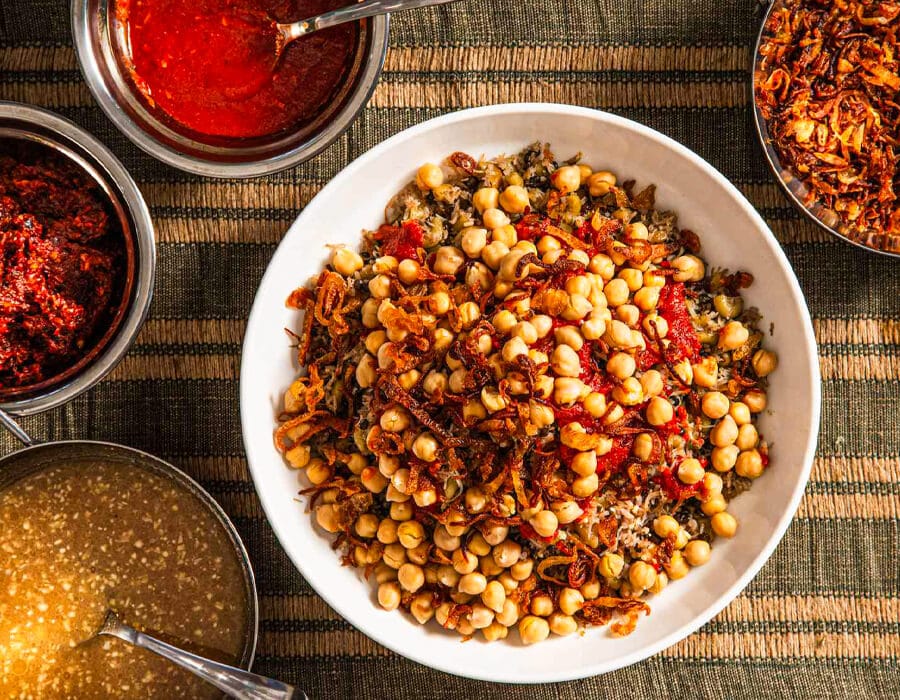
Widely considered Egypt’s unofficial national dish, koshari (also spelled kushari) is a hearty, carb-loaded comfort food that perfectly represents Egypt’s resourceful and multicultural cooking style. It combines lentils, rice, elbow macaroni, and chickpeas, all layered and topped with a zesty tomato-vinegar sauce, crispy fried onions, and optional garlic vinegar or chili oil for extra kick.
What may sound like a chaotic mix of pantry staples is a masterclass in textures and balance—the starches absorb flavor, the onions add crunch, and the sauce ties everything together. It’s vegetarian by default, making it accessible to a wide audience, and is often eaten as both street food and home-cooked fare.
🍽️ Pro Tip: The best koshary experience is at Abu Tarek Koshary Restaurant in downtown Cairo. Ask for it “spicy” if you like heat—just be ready for a serious kick!
2- Ful Medames: The Breakfast Staple
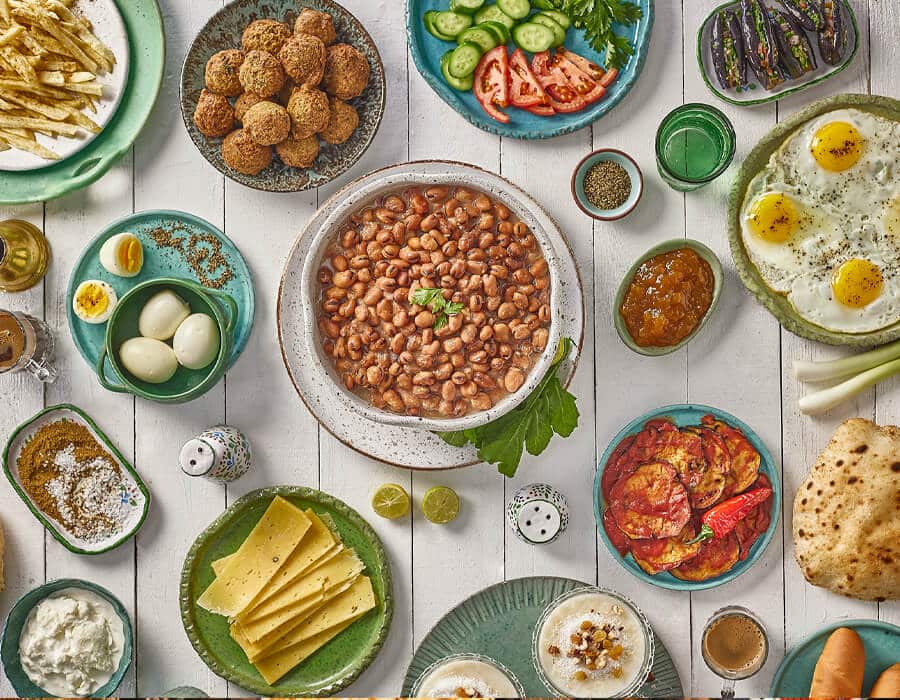
One of the oldest and most iconic dishes in Egyptian cuisine, Ful Medames is a hearty stew made from slow-simmered fava beans, seasoned with olive oil, garlic, lemon juice, and sometimes cumin or chili peppers. It’s Egypt’s go-to breakfast—and has been for thousands of years, dating all the way back to the time of the pharaohs.
Usually served warm, ful is enjoyed with aish baladi (Egyptian flatbread) and a selection of toppings such as hard-boiled eggs, tahini, pickled vegetables, or chopped parsley. Its rich, earthy flavor and dense texture make it both nutritious and satisfying, perfect for starting the day with lasting energy.
🧾 Cultural Note: In Egyptian households, ful is often prepared overnight in large metal pots and eaten fresh in the morning—either at home or from street-side food carts.
💡 Nutritional Snapshot
- High in protein and fiber
- Naturally vegan and gluten-free (depending on toppings)
- A great source of iron, magnesium, and complex carbohydrates
3- Ta’ameya: The Egyptian Falafel
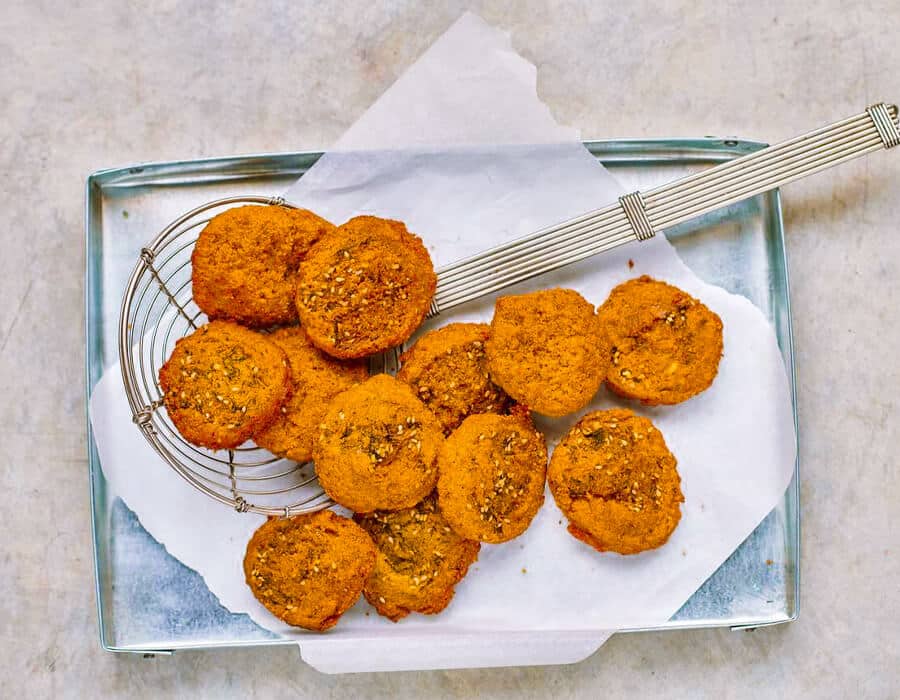
If you think you know falafel, think again—Egypt’s ta’ameya offers a refreshing twist on the classic Middle Eastern street food. Unlike the chickpea-based falafel found elsewhere, Egyptian ta’ameya is made with crushed fava beans, blended with leeks, green onions, parsley, cilantro, and bold spices. This gives it its signature vibrant green interior, lighter texture, and deeply aromatic flavor.
Ta’ameya is usually deep-fried until crispy, sometimes rolled in sesame seeds for added crunch, and tucked into aish baladi with pickled vegetables, fresh tomatoes, and tahini sauce. It’s a staple of Egyptian breakfasts and a popular snack throughout the day.
🌿 Why it stands out: The use of fresh herbs and fava beans makes Egyptian ta’ameya not only more colorful but also more herbaceous and less dense than its Levantine cousin.
🌱 Vegan-Friendly & Nutritious
- 100% plant-based
- Packed with protein and iron
- Low-cost and widely available
4- Molokhia: The Iconic Green Soup
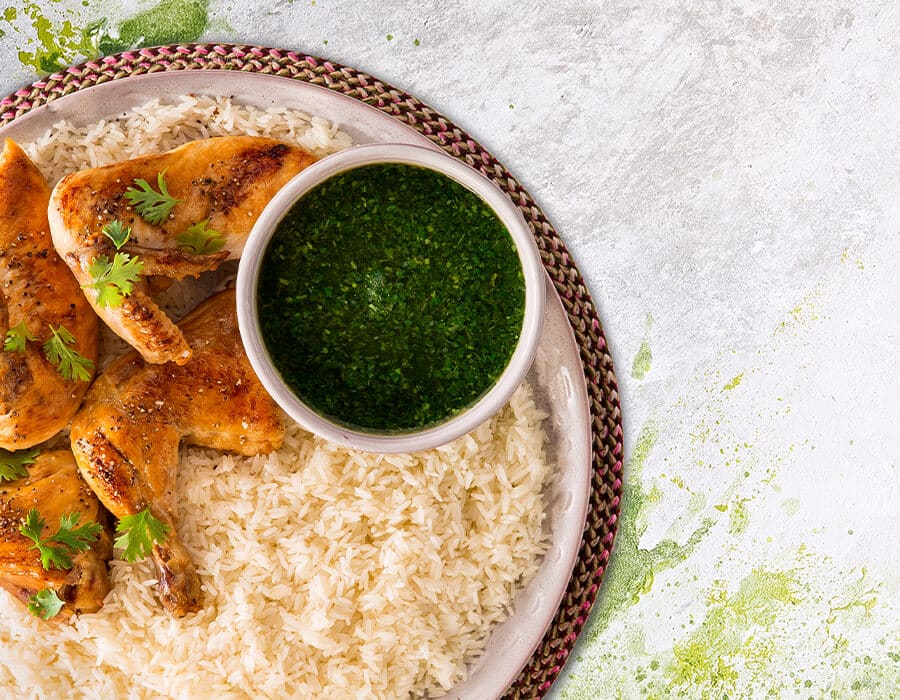
A dish as polarizing as it is beloved, Molokhia (also spelled mulukhiyah or molokheya) is a green, garlicky soup made from jute leaves, simmered with garlic, ground coriander, and a flavorful broth—typically chicken, beef, or rabbit. This silky, somewhat viscous soup is a staple across Egypt and is deeply rooted in ancient Egyptian cuisine, with some historians tracing its use back to the time of the pharaohs.
Molokhia is typically served with white rice or aish baladi, and topped with a sizzling ta’leya—a fragrant blend of garlic and coriander sautéed in ghee or butter, added at the last moment to release an aromatic punch. A squeeze of lemon juice is often added just before eating to brighten the flavor.
🥄 Texture Tip: Molokhia has a naturally slippery consistency, which can be surprising to newcomers but is adored by locals for its rich, earthy flavor.
🍃 Cultural Significance
- Often prepared for Friday family lunches or special occasions
- Commonly paired with Hamam Mahshi (stuffed pigeon) or roast chicken
- A staple during Ramadan and winter months for its comforting warmth
5- Fatta: A Feast-Worthy Dish
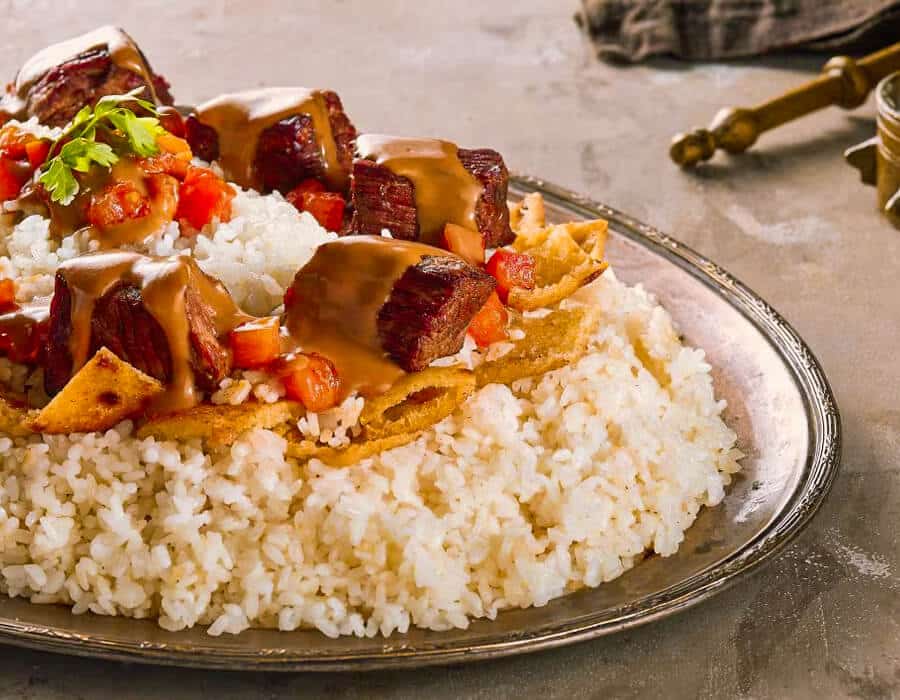
If there’s one dish that screams celebration in Egyptian culture, it’s Fatta. Reserved for special occasions like Eid al-Adha, weddings, and large family feasts, fatta is a rich, comforting dish made by layering toasted or fried pita bread, fluffy white rice, and tender cuts of slow-cooked lamb or beef. It’s then drenched in a pungent, tangy garlic and vinegar tomato sauce that ties it all together.
The contrast of textures—the crispy bread, soft rice, and melt-in-your-mouth meat—makes every bite an indulgent experience. It’s a communal dish meant for sharing, often served in large trays and passed around a bustling table of relatives and friends.
🍖 Pro Tip: Ask for a drizzle of the meat’s cooking broth on top for extra depth of flavor. Some households add chickpeas or yogurt sauce for a regional twist.
🎉 When & Why Egyptians Eat Fatta
- Eid al-Adha (Feast of Sacrifice): Fatta is traditionally served after the morning prayers using freshly sacrificed lamb.
- Post-Ramadan: It’s a popular iftar dish to break the month-long fast with something hearty and symbolic.
- Weddings & Birth Celebrations: Seen as a sign of generosity and abundance.
6- Mahshi: Stuffed Vegetables Done Right
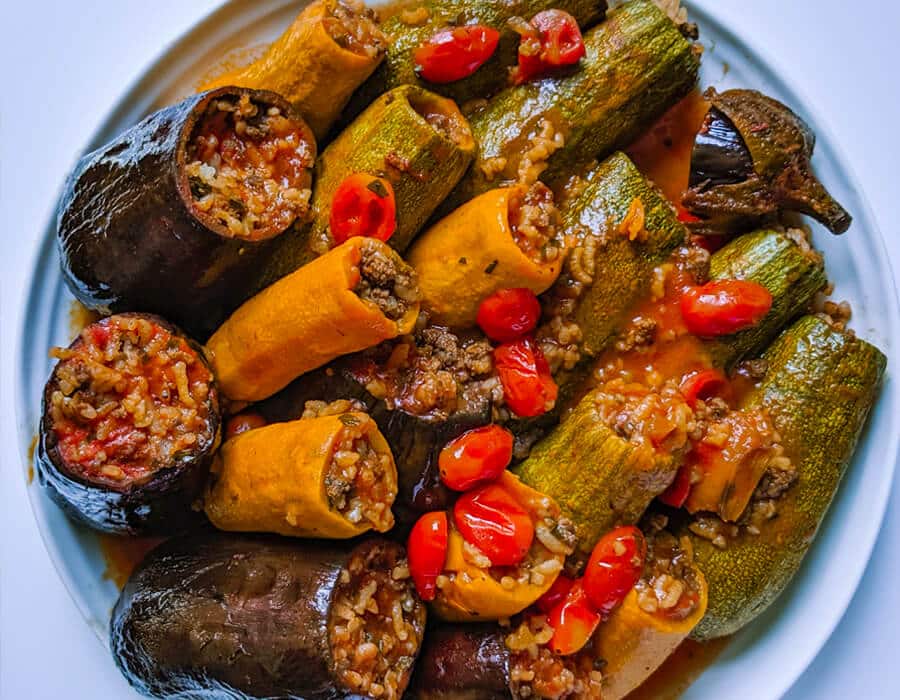
Mahshi is Egypt’s answer to the Mediterranean dolma and one of the country’s most comforting and culturally cherished dishes. The name simply means “stuffed,” and the concept is elegantly simple yet endlessly satisfying: vegetables like zucchini, eggplant, bell peppers, grape leaves, and even cabbage rolls are hollowed out and filled with a savory mixture of short-grain rice, fresh herbs (dill, parsley, mint), tomatoes, and spices.
The stuffed vegetables are then gently simmered in a spiced tomato broth, often with a hint of cinnamon or allspice, allowing them to absorb all the rich flavors during slow cooking. Meat—usually minced beef or lamb—is sometimes added to the filling for an even heartier version.
🥄 Family Tip: Mahshi is often a multi-generational effort, with families gathering to prep large batches during holidays, Ramadan, or weekend meals.
🌿 What Makes Mahshi Special
- Universally loved among both vegetarians and meat lovers
- Reflects Egypt’s use of seasonal, affordable ingredients
- Common during fasting periods, especially Coptic Lent and Ramadan
Popular Varieties
- Kousa Mahshi – Stuffed zucchini
- Betingan Mahshi – Stuffed eggplant
- Waraq Enab – Grape leaves (especially common in Alexandria and Upper Egypt)
- Koronb Mahshi – Stuffed cabbage rolls (often served in winter)
7- Hawawshi: Egyptian Meat Pie
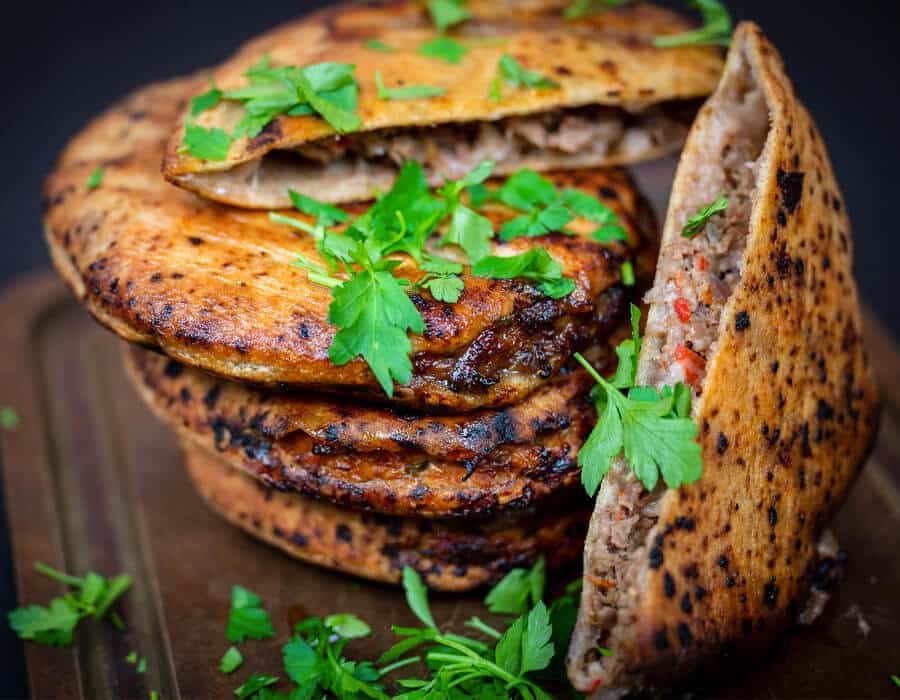
Hawawshi is Egypt’s flavorful answer to a meat pie—crispy on the outside, juicy on the inside, and deeply satisfying. This beloved street food staple features spiced minced beef or lamb mixed with onions, garlic, parsley, bell peppers, and warm spices like cumin, paprika, and chili, all stuffed into aish baladi (Egyptian flatbread) or dough and baked until golden and crispy.
Each bite delivers a delicious contrast of crispy edges, moist filling, and bold flavor. It’s typically enjoyed with a side of pickled vegetables, yogurt sauce, or hot chili paste. In Alexandria, you’ll even find a variant made with flaky pastry dough for an extra indulgent twist.
🔥 Locals know: The spiciness of hawawshi varies—some vendors bring the heat, while others keep it mild. Always ask if you’re spice-sensitive.
🛺 Where to Eat Hawawshi
- Popular in street food carts, bakeries, and fast-food joints
- Available in both beef and lamb variations
- Often eaten as a grab-and-go lunch or satisfying snack
🍴 Nutrition Note
While indulgent, hawawshi is also protein-rich and filling. Leaner meat cuts and baking (instead of frying) make it a more balanced option.
8- Besarah: A Vegetarian Delight

Besarah (also spelled bessara) is one of Egypt’s most underrated yet beloved vegetarian dishes. This smooth, herbaceous green purée is made by blending slow-cooked fava beans with fresh green herbs like parsley, dill, and coriander, along with garlic, onions, and spices such as cumin and chili flakes. The result is a vibrant, earthy dip or spread that’s packed with flavor and nutrition.
Traditionally served warm or at room temperature, besarah is scooped up with aish baladi or pita bread and often drizzled with olive oil and a pinch of red pepper flakes. Some families garnish it with caramelized onions or serve it as part of a larger mezze-style meal.
Cultural Insight: Besarah has roots in rural Egyptian cooking, especially in Upper Egypt and the Nile Delta, where beans and herbs are dietary staples due to their affordability and abundance.
🌿 Why It’s a Staple for Vegetarians
- 100% vegan and gluten-free (when served without bread)
- Rich in plant-based protein, fiber, and iron
- Simple, affordable, and deeply nourishing
🥣 How It’s Enjoyed
- As a side dish, light lunch, or dip
- During Lenten fasting periods in Christian Egyptian communities
- Paired with pickles, olives, and fresh cucumbers
9- Kebda Eskandarani: Alexandria’s Spiced Liver
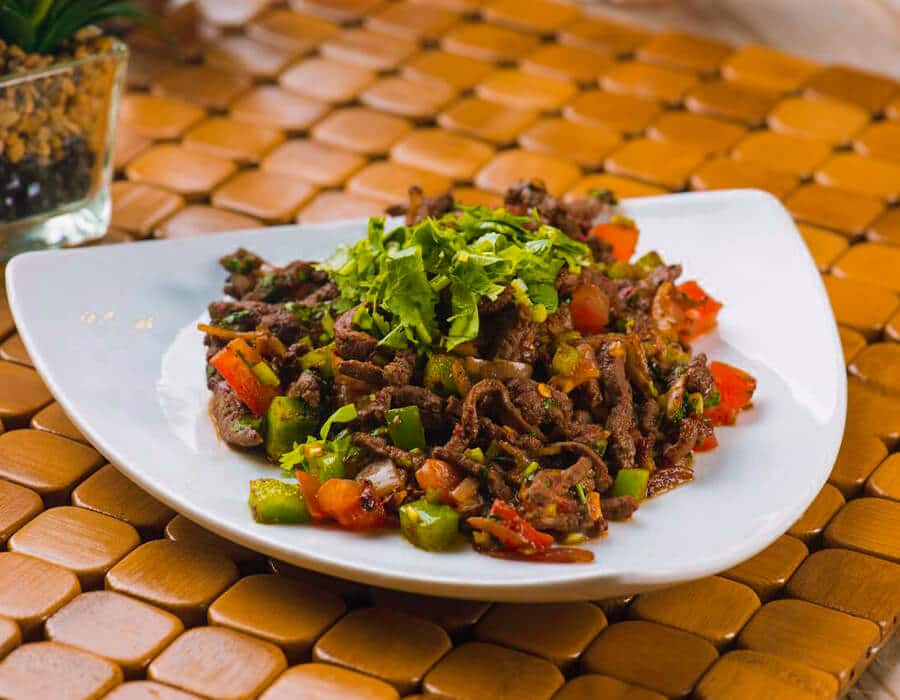
If you’re a fan of bold flavors and offal done right, Kebda Eskandarani (Alexandrian-style liver) is a must-try. This street food classic hails from the coastal city of Alexandria, where it’s loved for its intense seasoning, fiery spice, and quick preparation.
Thinly sliced beef liver is sautéed in a hot skillet with a powerful mix of garlic, cumin, chili peppers, vinegar, and green bell peppers. The result? A punchy, savory dish with a slightly tangy, spicy edge that awakens the palate. It’s typically served in Egyptian bread (aish baladi) as a sandwich or plated with pickles, fries, and tahini sauce.
🌶️ Local’s Tip: Liver lovers should try it spicy, but if you’re new to organ meats, ask for a milder version—some street vendors customize heat levels.
A Street Food Icon
- Found at sandwich shops, carts, and family diners across Alexandria and Cairo
- Especially popular among university students and workers for its affordability and fast prep time
- One of Egypt’s most flavorful examples of how humble ingredients can be elevated with spices
Nutritional Value
- High in iron and B vitamins, making it a nutritious choice in moderation
- Best eaten fresh due to liver’s delicate texture
- Often enjoyed as part of Ramadan iftar meals for its quick energy boost
10- Sayadiyah: Fish, the Egyptian Way
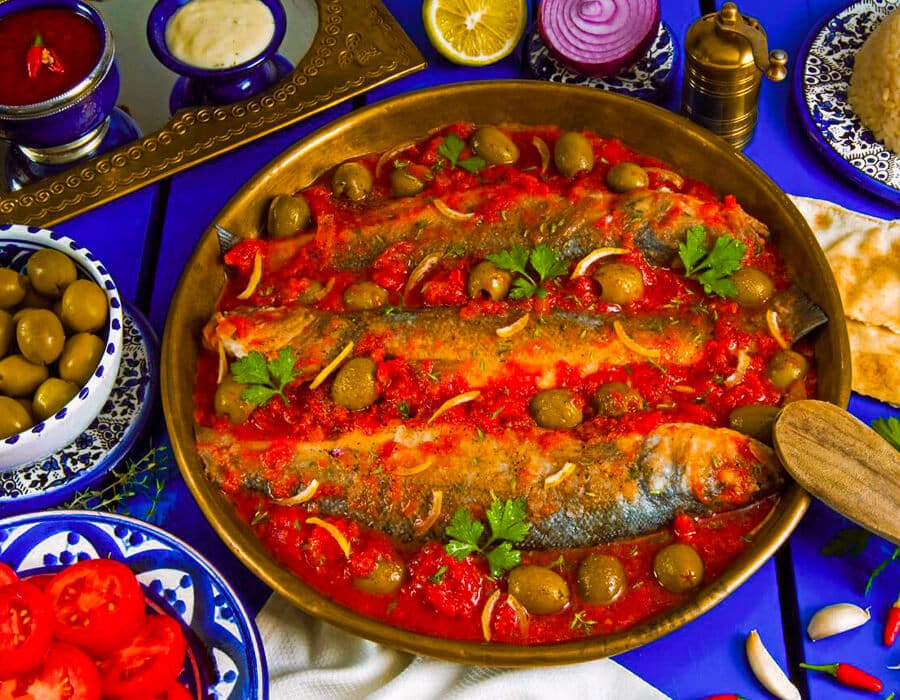
Hailing from Egypt’s northern port cities like Alexandria and Port Said, Sayadiyah is a fragrant, rustic seafood dish that celebrates the bounty of the Mediterranean. Traditionally made with white fish—such as sea bass, mullet, or tilapia—it’s cooked with caramelized onions, tomato paste, garlic, spices (like cumin and coriander), and bay leaves, then served over a bed of spiced brown or white rice that’s infused with the cooking juices.
The secret to great sayadiyah lies in the deeply browned onions, which add a sweet, smoky base to the dish and color the rice a golden hue. It’s often accompanied by tahini sauce, pickled vegetables, or a green salad with lemon dressing for a bright contrast.
Where & When It’s Eaten
- Most popular in Alexandria, Port Said, and Damietta
- A common Friday lunch or festive meal
- Served at family restaurants and beachside cafés along the coast
Key Components
- Fish: Typically firm white fish that holds up to stewing or baking
- Rice: Cooked in fish broth and onions for maximum flavor
- Spices: Cumin, coriander, black pepper, and bay leaf
- Optional Garnish: Fried onions, toasted nuts, or a lemon wedge
11- Hamam Mahshi: Stuffed Pigeon
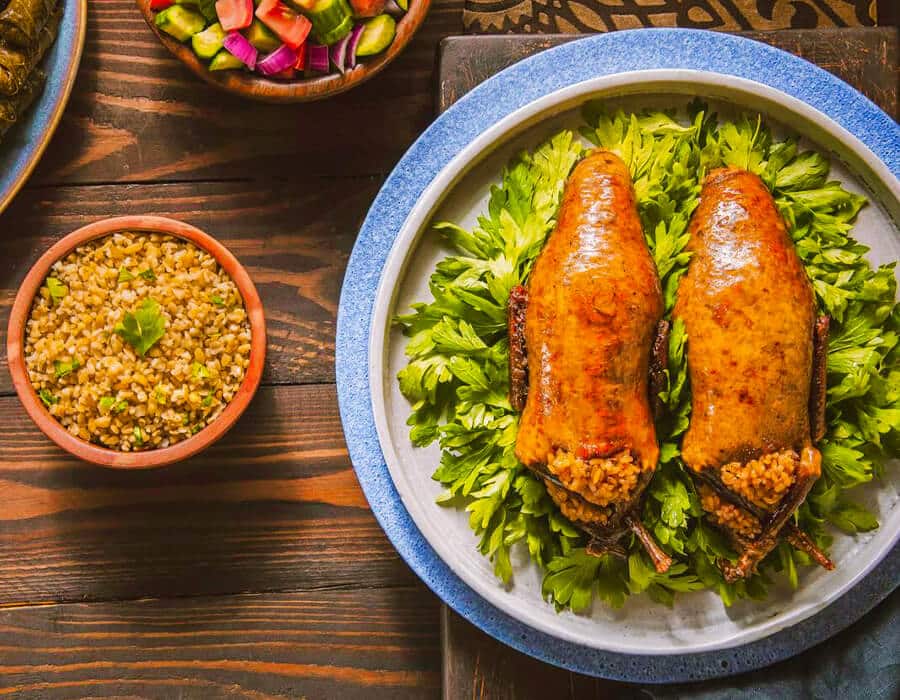
A dish reserved for the bold—and the fortunate—Hamam Mahshi (stuffed pigeon) is one of Egypt’s most revered and luxurious traditional meals. These plump, young pigeons are delicately stuffed with a seasoned mix of rice or freekeh (roasted green wheat), simmered in spiced broth, and then either grilled, pan-seared, or oven-roasted to crispy, golden perfection.
The result is a dish that’s both intensely flavorful and rich in cultural significance, with crisp skin, tender meat, and stuffing that’s soaked in the juices of the bird. It’s a favorite at weddings, Eid feasts, and important family gatherings, and is typically served alongside molokhia or aish baladi for a complete traditional meal.
🕊️ Cultural Note: Pigeons have been consumed in Egypt since the Pharaonic era, and many Egyptian farms still raise them in mudbrick dovecotes, a centuries-old method.
Stuffing Options
- Rice with cinnamon, cardamom, and nuts
- Freekeh for a nutty, chewy texture and higher fiber
- Herbs like dill, parsley, and onion often added for depth
Why It’s Special
- Considered a gourmet dish in Egyptian culture
- Found in traditional restaurants and high-end rural guesthouses
- Symbolizes generosity and hospitality, especially during feasts
12- Falafel Sandwiches: A Street Food Must

If there’s one street food you’ll find at nearly every corner in Egypt, it’s the iconic falafel sandwich—or as it’s known locally, ta’ameya. These handheld delights are made with crisp, golden discs of fava bean falafel, tucked into freshly baked aish baladi and loaded with a medley of vibrant toppings.
The standard sandwich is layered with tahini sauce, pickled vegetables, cucumber, tomato, and sometimes even fried eggplant or potatoes. The result? A portable meal that’s savory, creamy, tangy, and crunchy all at once.
🛒 Pro Tip: For just a few Egyptian pounds, you can enjoy one of the tastiest vegetarian meals in the world—no utensils required.
What’s Inside a Classic Egyptian Falafel Sandwich?
- Ta’ameya – Fluffy falafel made from ground fava beans, herbs, and spices
- Tahini sauce – Sesame-based dip that adds a rich, nutty flavor
- Salata baladi – Chopped tomato, cucumber, and parsley salad
- Pickled turnips or carrots – For acidity and crunch
- Optional extras – Fried eggplant, French fries, or boiled eggs
Why It’s a Street Food Star
- Super affordable and filling
- Ready in minutes, making it ideal for breakfast or quick lunch
- Universally loved by locals and tourists alike
- Found in food carts, bakeries, cafés, and even gas stations
13- Egyptian Pickles: A Tangy Sidekick
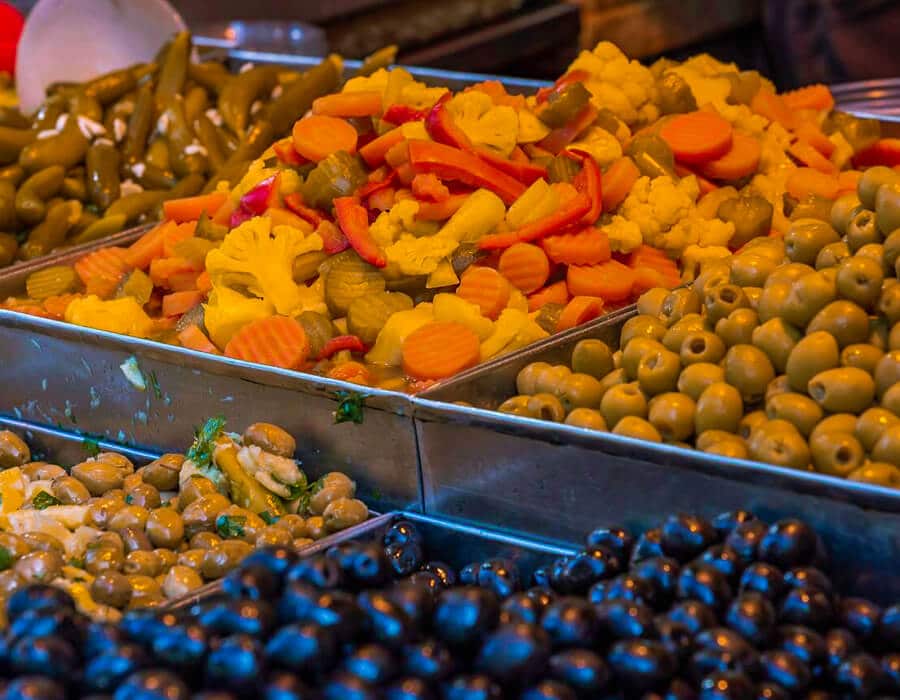
No Egyptian meal feels complete without a small plate of mekhalel—an assortment of brightly colored, boldly flavored Egyptian pickles. These crunchy, salty, sour sidekicks cut through the richness of heavier dishes like koshari, hawawshi, or hamam mahshi, adding balance and brightness to every bite.
Egyptian pickles are made from a rotating mix of seasonal vegetables such as cucumbers, turnips, carrots, green chilies, cauliflower, and even eggplant, brined in a vinegar, salt, garlic, and mustard seed solution. They’re often fermented with dill, coriander seeds, or bay leaves, resulting in an intensely aromatic profile that varies by region and household.
🥒 Food Culture Tip: In Egypt, every street sandwich vendor and home kitchen keeps a jar of pickles nearby—because flavor is everything, and contrast is king.
Common Pickled Vegetables in Egypt
- Lifton (Turnips): Often dyed pink with beetroot
- Khiar (Cucumbers): Firm, salty, and slightly spicy
- Gazar (Carrots): Mild, with a touch of sweetness
- Mekhalel Betingan (Eggplant): Stuffed with garlic and chili—especially common in Upper Egypt
Why They Matter
- Boost digestibility of heavier, oily dishes
- Add a sharp, salty contrast that enhances main flavors
- Rich in gut-friendly probiotics when naturally fermented
Often homemade using time-honored family recipes
14- Shorbat Ads: Egyptian Lentil Soup
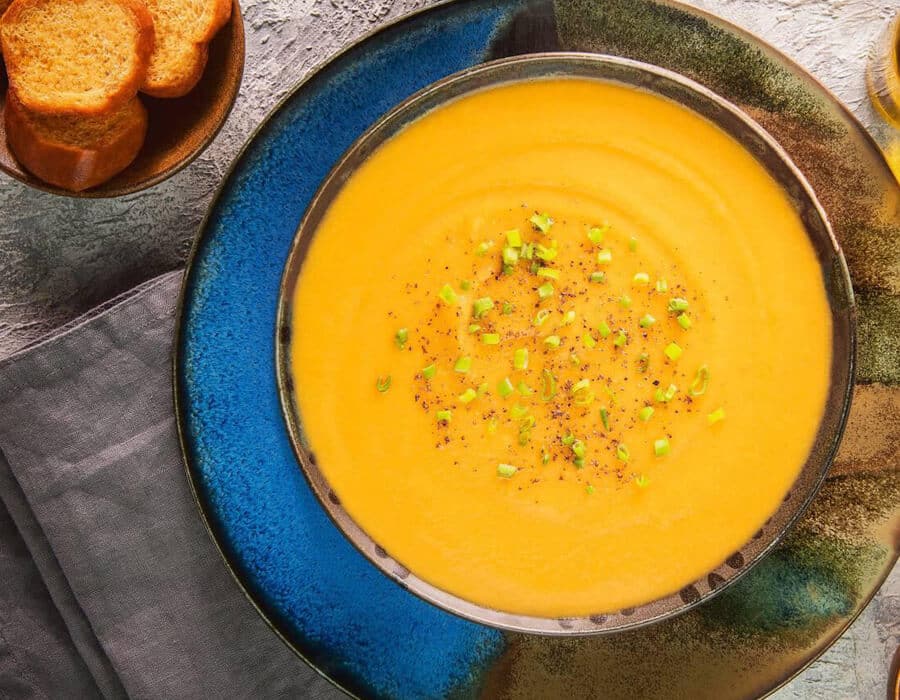
Shorbat Ads (شوربة عدس), or Egyptian lentil soup, is the definition of comfort in a bowl. Made with red lentils, this thick, hearty soup is simmered with onions, garlic, carrots, tomatoes, and warming spices like cumin, coriander, turmeric, and a pinch of black pepper. It’s then blended until smooth, resulting in a silky, earthy dish that’s perfect for both Ramadan meals and cozy winter evenings.
Beyond its soothing flavor, shorbat ads is loved for being incredibly affordable, nutritious, and filling. It’s a staple during religious fasting, a go-to for meatless Mondays, and a common first course in Egyptian homes and restaurants alike.
🥣 Cultural Note: Many Egyptian families break their fast with lentil soup during Ramadan, making it a deeply nostalgic and spiritual part of the culinary calendar.
Key Ingredients
- Red lentils – Quick-cooking and high in protein
- Aromatics – Onion, garlic, and carrot for depth
- Spices – Cumin, turmeric, and sometimes chili
- Liquid – Vegetable or chicken broth
Traditional Garnishes
- A drizzle of olive oil or ghee
- A squeeze of fresh lemon juice
- Croutons or aish baladi on the side
- A dusting of cumin or chili powder.
15- Aish Baladi: The Egyptian Bread

Translating to “bread of the land,” aish baladi (عيش بلدي) is more than just bread—it’s a national symbol of sustenance, culture, and pride. Made from whole wheat flour, water, salt, and yeast, this round, pocket-style flatbread is baked in scorching-hot clay ovens, which cause it to puff dramatically as it cooks, creating its signature air pocket.
Aish baladi is ubiquitous in Egyptian cuisine. It’s used to scoop up dishes like molokhia, ful medames, koshari, or ta’ameya, and often serves as a utensil itself. Its chewy texture and nutty flavor make it the perfect vehicle for both hearty and delicate flavors.
🍞 Cultural Insight: The word “aish” comes from the Arabic root for “life,” underscoring how vital bread is to Egyptian identity. During economic hardship, bread subsidies are fiercely protected.
How It’s Made
- Traditionally baked in wood-fired or clay taboons
- Sprinkled with bran on the outside to prevent sticking
- Can be made at home with a pizza stone or cast iron skillet
Uses in Egyptian Cuisine
- Wrap for falafel or kebda eskandarani
- Base for fatta when toasted or fried
- Side to soak up soups, stews, and dips
- Even used to scoop salads or pickles
Nutritional Notes
- Made with whole wheat, making it higher in fiber and minerals than white pita
- Often part of vegan or vegetarian diets
- Extremely affordable and accessible throughout Egypt
16- Konafa: The Sweet Delight
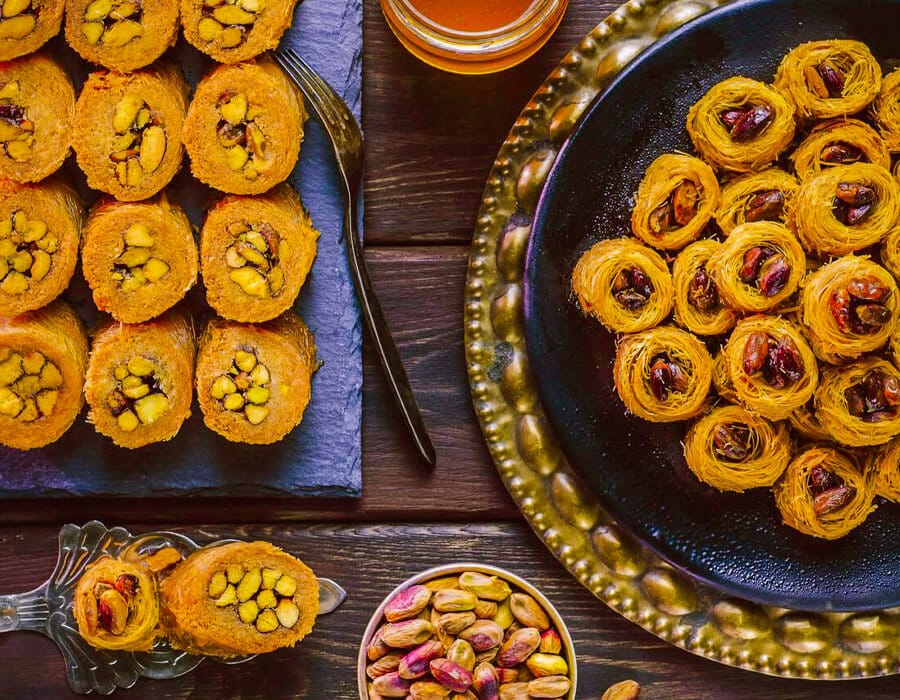
Konafa (also spelled kunafa or kanafeh) is one of Egypt’s most celebrated desserts, especially during Ramadan and festive occasions. Made with shredded kataifi dough (a fine, noodle-like phyllo), konafa is layered with creamy fillings—such as clotted cream (eshta), sweet cheese, custard, or crushed nuts—then baked to golden perfection and drenched in a fragrant sugar syrup infused with rose water or orange blossom.
With its contrast of crunchy exterior and gooey interior, konafa delivers a multisensory dessert experience. Served warm, it melts in your mouth—leaving behind the sweetness and subtle floral aromas that define traditional Middle Eastern confections.
🍰 Modern Variations: Today, konafa has gone viral on social media thanks to inventive twists like mango konafa, Nutella-filled versions, and even ice cream konafa cups in upscale Cairo cafés.
Types of Egyptian Konafa Fillings
- Eshta (cream): Traditional, light, and custard-like
- Nuts: Often walnuts, pistachios, or almonds, mixed with cinnamon
- Sweet cheese: Common in Alexandria and borrowed from Levantine traditions
- Fruits: Modern recipes include mango or berries for a seasonal spin
Preparation Notes
- Kataifi dough is brushed generously with clarified butter (samna) before baking
- Syrup is poured on while the pastry is hot, ensuring maximum absorption
Topped with crushed nuts or coconut flakes for extra texture
17- Basbousa: The Semolina Cake
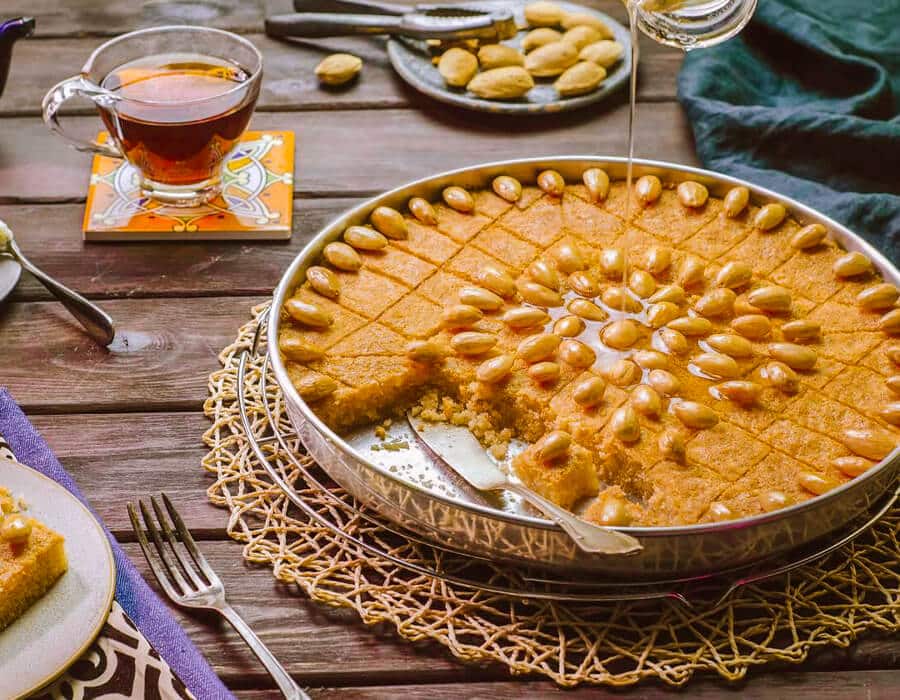
Basbousa is one of Egypt’s most classic and widely adored desserts. Made with coarse semolina, yogurt, ghee or butter, and a hint of coconut, this golden cake is baked until lightly crisp on the edges, then drenched in warm sugar syrup—sometimes infused with rose water or lemon zest.
Cut into diamond or square shapes and often topped with a single blanched almond or shredded coconut, basbousa is moist, rich, and perfectly balanced between soft and dense. It’s served at family gatherings, festive holidays, and coffee breaks, often alongside a cup of mint tea or Turkish coffee.
🍯 Cultural Note: Basbousa isn’t just Egyptian—it’s popular across the Middle East and North Africa. But Egypt has made it uniquely its own with local adaptations and generous use of coconut.
What’s in a Classic Basbousa?
- Semolina – Provides that distinct sandy texture
- Yogurt or milk – For moisture and mild tang
- Butter or ghee – Adds richness and flavor
- Sugar syrup (sharbat) – Soaks the cake after baking
- Optional: Desiccated coconut, rose water, or orange blossom
When Is Basbousa Served?
- During Ramadan, Eid, and birthdays
- With tea or coffee as an afternoon sweet
Offered to guests as a traditional hospitality gesture
18- Om Ali: Egypt’s Bread Pudding
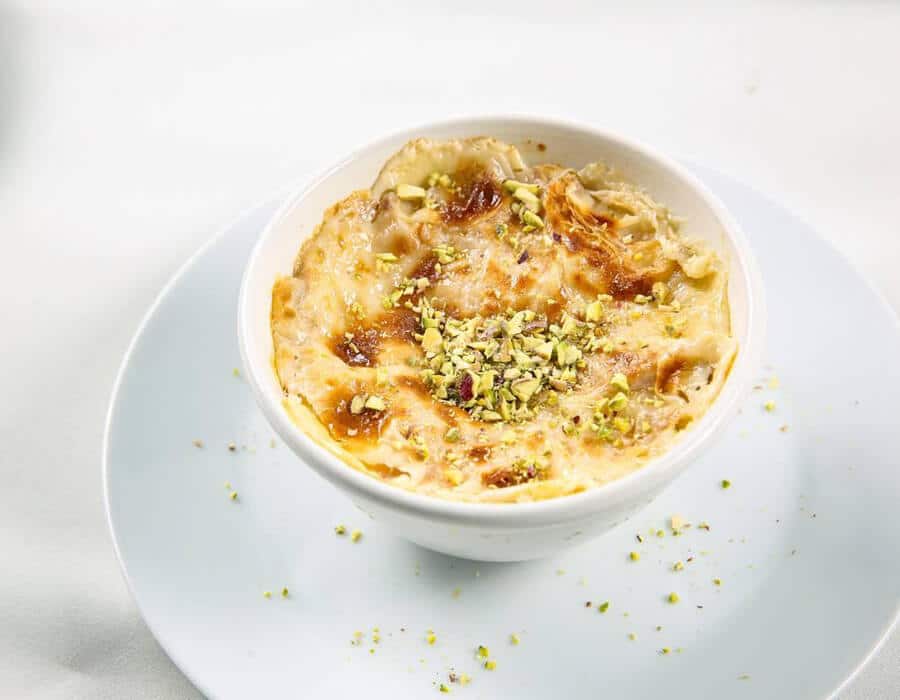
Om Ali, meaning “Ali’s mother,” is Egypt’s most beloved warm, creamy bread pudding, rich in history, texture, and flavor. This festive dessert is made by layering flaky pastry, puff pastry, or old bread with milk, sugar, nuts (like pistachios, almonds, or hazelnuts), and raisins, then baked until the top turns golden and slightly crisp while the inside stays soft and custard-like.
Served warm and often scooped straight from the baking dish, Om Ali is the go-to dessert for big occasions, especially after feasts like Eid al-Fitr, weddings, or large family dinners. Its richness and nostalgia make it feel like a sweet embrace in every spoonful.
🥧 Historical Note: Legend says Om Ali was first made to celebrate a royal succession in the Ayyubid dynasty, cementing it as a dessert tied to triumph and festivity.
Key Ingredients
- Base: Croissant pieces, puff pastry, toasted baladi bread, or even phyllo
- Dairy: Hot milk or cream poured over the dry base
- Add-ins: Nuts, coconut flakes, raisins, cinnamon
- Topping: Optional sugar crust or shredded coconut, lightly baked
Serving Tips
- Best enjoyed warm and fresh out of the oven
- Can be made ahead and reheated, though fresh milk soak is best
- Often topped with a scoop of cream or ice cream in modern versions
19- Roz Bel Laban: Egyptian Rice Pudding

Roz Bel Laban, meaning “rice with milk,” is Egypt’s answer to comfort food dessert—simple, creamy, nostalgic, and universally loved. This silky pudding is made by slowly cooking short-grain rice in whole milk with sugar, and often flavored with vanilla, rose water, or orange blossom. It’s gently simmered until thickened to a rich, spoonable consistency.
Traditionally served chilled in glass bowls and topped with a sprinkle of cinnamon, crushed pistachios, or raisins, Roz Bel Laban is a common sight in home kitchens, dessert shops, and Ramadan tables across Egypt.
🥄 Cultural Note: Roz Bel Laban is not just a dessert—it’s a taste of childhood for many Egyptians, often made by grandmothers and served after a hearty family meal.
Key Ingredients
- Short-grain rice – Egyptian or arborio varieties work best
- Whole milk – For a creamy, full-bodied base
- Sugar – Lightly sweetened to taste
- Optional flavors: Vanilla, rose water, mastic, cardamom
Topping Ideas
- Ground cinnamon for warmth
- Crushed nuts (pistachios or almonds) for texture
- A dollop of cream or a swirl of honey for richness
- Shredded coconut or raisins for added depth
20- Sahlab: A Cozy Winter Drink
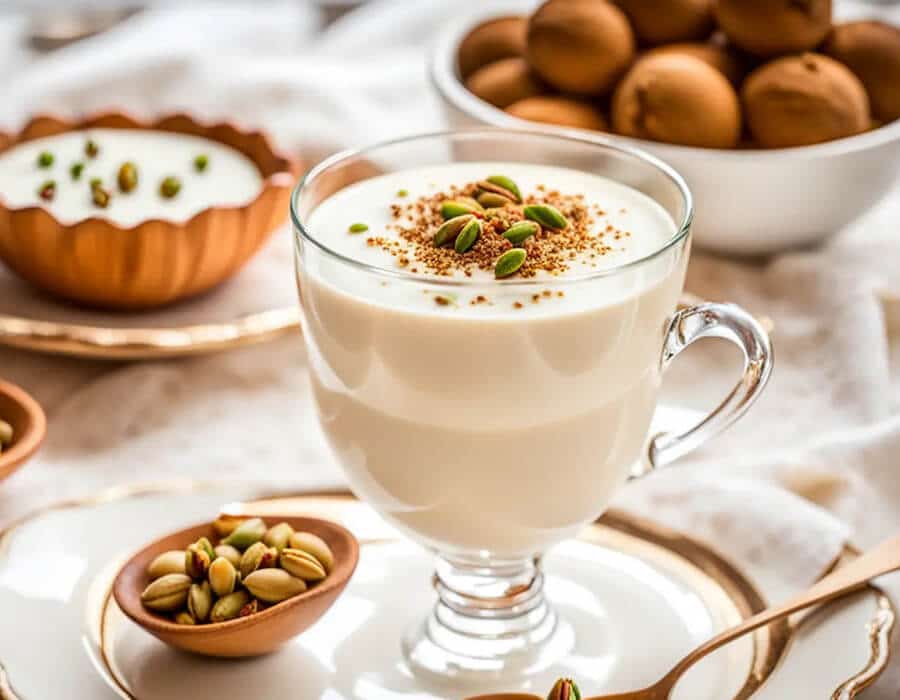
Sahlab is a comforting, thick, and creamy hot drink that’s cherished across Egypt during the cooler months. Traditionally made from orchid root powder (also called salep), milk, and sugar, this velvety beverage is gently heated and stirred until it reaches a pudding-like consistency, then poured into mugs and adorned with cozy toppings like cinnamon, shredded coconut, crushed pistachios, or golden raisins.
While modern sahlab is often made using cornstarch as a substitute for orchid powder (which is now rare and expensive), it still delivers the same warm, silky experience Egyptians love—especially during winter evenings, street strolls, or after-dinner family gatherings.
☕ Cultural Insight: In Egypt, sahlab is as much a tradition as it is a treat—you’ll often find it sold by vendors in cafés or winter street stalls, served piping hot in glass cups.
What’s in a Traditional Cup of Sahlab?
- Milk (or plant-based alternatives)
- Sahlab powder or cornstarch for thickening
- Sugar (adjustable for sweetness)
- Optional flavors: Vanilla, orange blossom, or rose water
Popular Toppings
- Ground cinnamon
- Shredded coconut
- Chopped nuts (almonds, walnuts, pistachios)
Golden raisins or mini marshmallows
🍴 Explore Egypt Through Food – Culinary Travel Tips for Every Food Lover
Egypt isn’t just a destination for ancient wonders—it’s a living, breathing culinary journey where every meal tells a story. Whether you’re wandering the souks of Cairo or dining under the stars in Luxor, the food you encounter is a gateway into the country’s deep cultural identity. Here’s how to turn your Egyptian trip into a true culinary adventure:
🥙 1. Eat Like a Local
Skip the hotel buffet. The real magic happens at family-run restaurants, hole-in-the-wall koshari joints, and falafel carts buzzing with locals.
- Cairo: Grab breakfast from a ta’ameya vendor in Zamalek or try a steaming bowl of ful from a cart near Tahrir Square.
- Alexandria: Head to the Corniche for fresh seafood or liver sandwiches (Kebda Eskandarani) grilled right on the street.
- Aswan & Luxor: Try Nubian specialties with African and Egyptian fusion flavors.
📝 Pro Tip: Watch what the locals order—it’s usually the freshest and most flavorful item on the menu.
👨🍳 2. Join a Cooking Class or Food Tour
Hands-on experiences bring Egyptian cuisine to life. Many local tour operators offer home-based cooking classes where you’ll shop for ingredients in the market, learn traditional recipes like molokhia, mahshi, or fatta, and share the meal with a host family.
- Look for experiences on Airbnb, Viator, or Egypt-specific travel sites.
- Choose classes that explain spice use, cooking rituals, and cultural significance.
These experiences go beyond food—they offer insight into daily Egyptian life, hospitality, and family traditions.
🛍️ 3. Explore Egypt’s Bustling Food Markets
Markets (souks) are the heartbeat of Egyptian food culture. They’re loud, colorful, and bursting with spices, dates, pickles, breads, and fresh produce.
- Khan El Khalili (Cairo): Explore dried hibiscus, teas, and spice mountains.
- Attarine Market (Alexandria): Best for herbs, olives, and preserved lemons.
- Luxor Market: Great for buying homemade molokhia powder, saffron, and nuts.
Take your time to sample street snacks like roasted sweet potatoes, sahlab, or sesame-coated simit bread.
🌙 4. Visit During Ramadan or Local Festivals
Food takes on a new dimension during Ramadan. As sunset nears, the streets fill with the scent of cooking. Iftar (the meal to break the fast) is often a lavish spread of soups, dates, juices, stuffed vegetables, and sweets.
- Try konafa with cream or Nutella, basbousa, and Om Ali from dessert stands open late into the night.
- During Eid, savor meat-rich dishes like fatta and hamam mahshi in celebratory settings.
- In rural areas, join in communal meals shared in large trays—it’s an unforgettable show of Egyptian hospitality.
🗣️ 5. Talk to Locals—Food is Their Pride
Don’t be shy about asking where to eat. Egyptians are incredibly food-proud and will likely offer you not just directions but a story behind their favorite dish.
- Ask a taxi driver where to find the best koshari in town.
- Chat with your guesthouse host about their childhood favorite sweets.
- Visit a bakery and ask how aish baladi is made from scratch.
These connections create personal memories and introduce you to hidden gems no guidebook can match.
🏁 Conclusion: Egyptian Food – A Journey Through Flavor, Culture, and Time
Exploring Egyptian cuisine is far more than a culinary experience—it’s a voyage through ancient history, vibrant street life, and heartfelt hospitality. From the spice-laden lentils of shorbat ads to the golden crunch of konafa, every dish tells a story rooted in tradition, geography, and community.
Whether you’re savoring a street-side ta’ameya sandwich, dipping warm aish baladi into creamy ful medames, or sharing a family-style platter of mahshi or fatta, you’re not just eating—you’re participating in centuries of Egyptian food heritage.
As you travel through Egypt—or recreate these dishes at home—remember that food here is more than sustenance. It’s a language of love, a symbol of resilience, and a gateway to understanding the soul of the nation.
🇪🇬 One Bite at a Time: Let the bold flavors, comforting textures, and timeless recipes draw you into Egypt’s rich and delicious story. Because in Egypt, every bite is history—and every meal is a memory waiting to be made.
